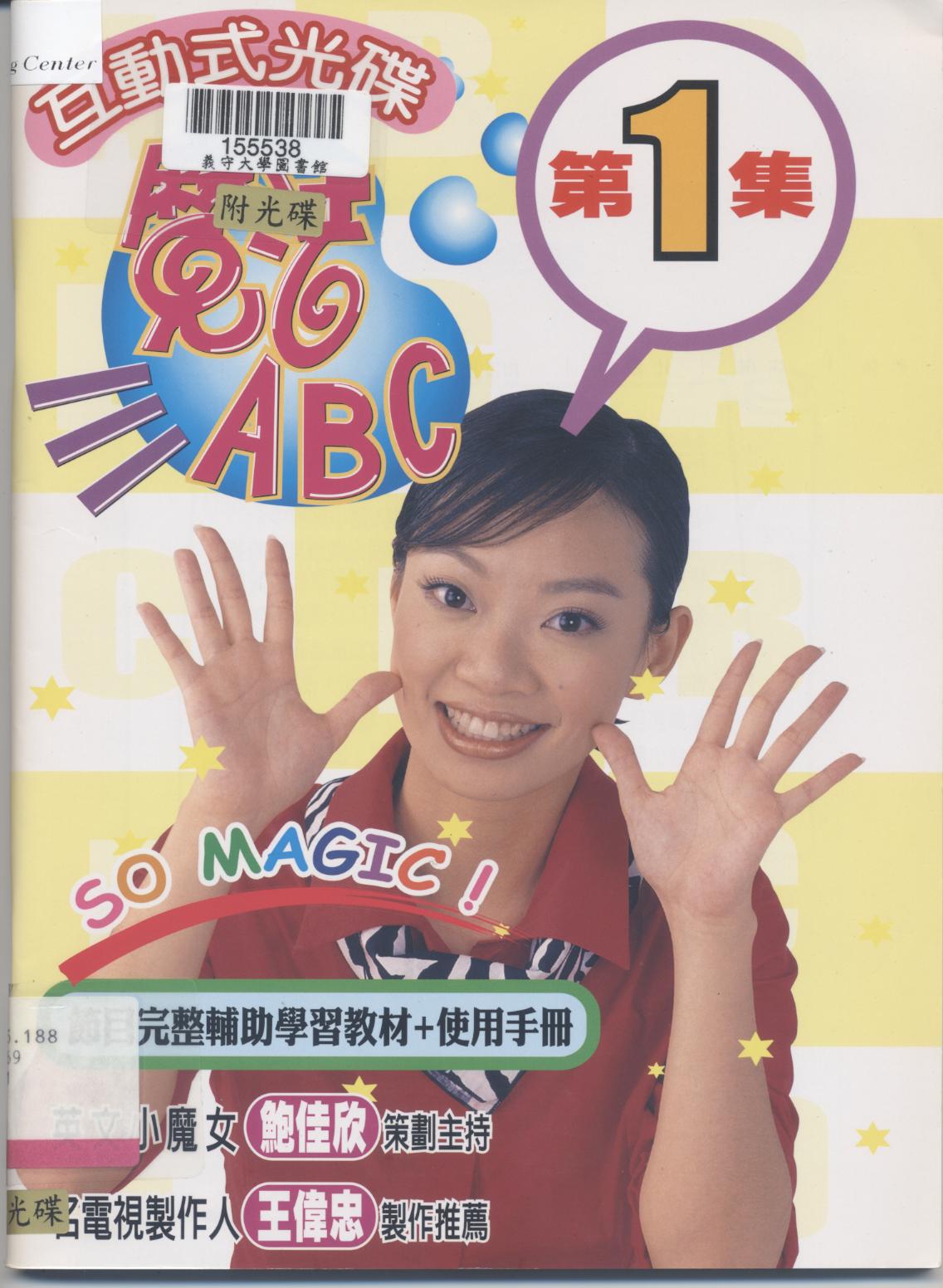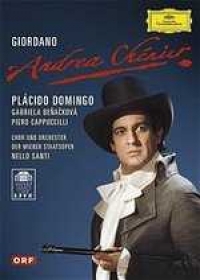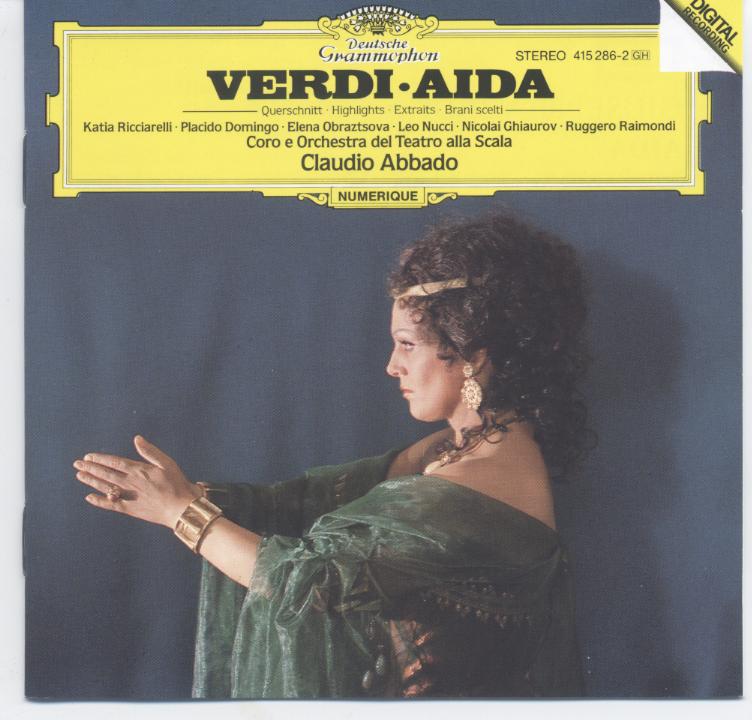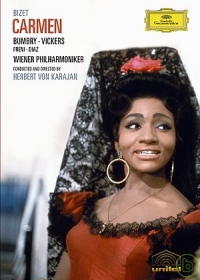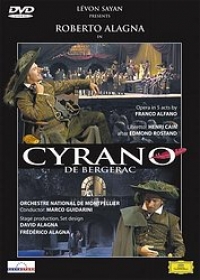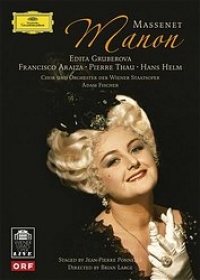This filmed version of Strauss' shocker features Teresa Stratas as opera's most depraved teenager, and she's as perfect a Salome as one would ever hope to see or hear. Stratas inhabits the role, exploring the character's sensuousness as she vainly woos Jochanaan, her venomous hatred when she's rejected, the crazed look in her eyes when she demands his head--on a silver platter, no less. Such complete identification with a role, especially of a character so malignant helps make this 1974 Salome stand out among the many fine DVDs of the opera.
The visceral impact of the film owes much to Götz Friedrich's direction and Gerd Staub's sets. All of the action takes place in the courtyard of Herod's palace, but Friedrich exploits the claustrophobic possibilities of limited space by his deft camera angles that follow the singers and by copious close-ups that often show details unavailable to us when we see the opera live or even in a filmed stage performance: Stratas' face and eyes, which reflect her swift mood changes, Jochanaan's face, which shows his disgust, and the corrupt visages of Herod and Herodias. The cumulative effect of such close-ups heightens tension and creates an atmosphere in which we, the viewers, are thrust into the action. It's not always a comfortable experience but it's always an engrossing one. Staub's sets and the costumes designed by Jan Skalicky are more or less generic but functional, with nice touches like the headpiece Stratas wears, which emphasizes the reptilian slithering of her movements The veils in Salome's famous dance and some of the robes worn by the courtiers add touches of color to the overall grayness that emphasizes the claustrophobic elements of the opera.
While Stratas' overwhelming performance commands prime attention, the cast is a strong one. The great Wagnerian soprano Astrid Varnay, long past her vocal prime, is a venomous Herodiade whose facial expressions mirror her inner corruption. Varnay's portrayal comes perilously close to being over the top but that may be said of others in the cast, too, as Friedrich seems to encourage excess in an opera that wallows in it. Hans Beirer's lascivious Herod, for example, is also broadly interpreted, but very well done in the context of Friedrich's framework of a decadent sex-obsessed court. The role of Jochanaan is taken by Bernd Weikl whose sonorous singing and acting vividly portray his scorn for his captors and his repulsion at Salome's sexual aggressiveness.
The sound mix favors the singers and downgrades the orchestra, itself a central character, though rather attenuated, as it comments on the action and elaborates on the sung lines. Karl Böhm, a great Strauss conductor, leads the sumptuous Vienna Philharmonic in a performance that, in spite of its dim placement, illuminates Strauss' orchestration. All in all, this is a must-have Salome. --Dan Davis
This filmed version of Strauss' shocker features Teresa Stratas as opera's most depraved teenager, and she's as perfect a Salome as one would ever hope to see or hear. Stratas inhabits the role, exploring the character's sensuousness as she vainly woos Jochanaan, her venomous hatred when she's rejected, the crazed look in her eyes when she demands his head--on a silver platter, no less. Such complete identification with a role, especially of a character so malignant helps make this 1974 Salome stand out among the many fine DVDs of the opera.
The visceral impact of the film owes much to Götz Friedrich's direction and Gerd Staub's sets. All of the action takes place in the courtyard of Herod's palace, but Friedrich exploits the claustrophobic possibilities of limited space by his deft camera angles that follow the singers and by copious close-ups that often show details unavailable to us when we see the opera live or even in a filmed stage performance: Stratas' face and eyes, which reflect her swift mood changes, Jochanaan's face, which shows his disgust, and the corrupt visages of Herod and Herodias. The cumulative effect of such close-ups heightens tension and creates an atmosphere in which we, the viewers, are thrust into the action. It's not always a comfortable experience but it's always an engrossing one. Staub's sets and the costumes designed by Jan Skalicky are more or less generic but functional, with nice touches like the headpiece Stratas wears, which emphasizes the reptilian slithering of her movements The veils in Salome's famous dance and some of the robes worn by the courtiers add touches of color to the overall grayness that emphasizes the claustrophobic elements of the opera.
While Stratas' overwhelming performance commands prime attention, the cast is a strong one. The great Wagnerian soprano Astrid Varnay, long past her vocal prime, is a venomous Herodiade whose facial expressions mirror her inner corruption. Varnay's portrayal comes perilously close to being over the top but that may be said of others in the cast, too, as Friedrich seems to encourage excess in an opera that wallows in it. Hans Beirer's lascivious Herod, for example, is also broadly interpreted, but very well done in the context of Friedrich's framework of a decadent sex-obsessed court. The role of Jochanaan is taken by Bernd Weikl whose sonorous singing and acting vividly portray his scorn for his captors and his repulsion at Salome's sexual aggressiveness.
The sound mix favors the singers and downgrades the orchestra, itself a central character, though rather attenuated, as it comments on the action and elaborates on the sung lines. Karl Böhm, a great Strauss conductor, leads the sumptuous Vienna Philharmonic in a performance that, in spite of its dim placement, illuminates Strauss' orchestration. All in all, this is a must-have Salome. --Dan Davis

 館藏資料查詢 > 詳細資料
館藏資料查詢 > 詳細資料

 借閱次數:
借閱次數: 








